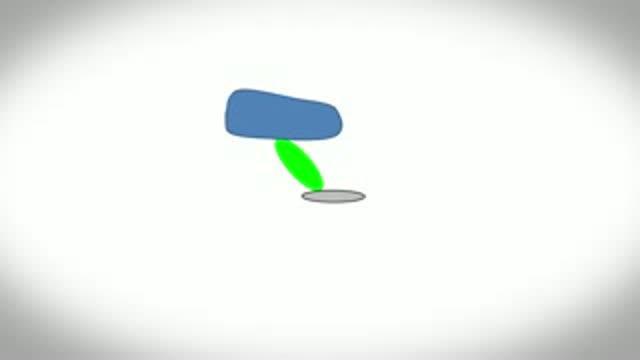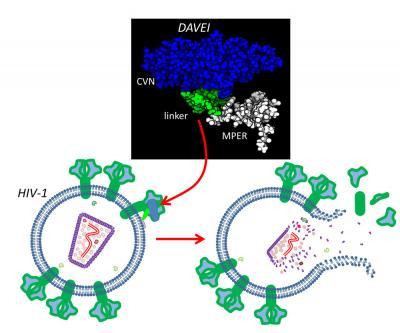The idea behind DAVEI was to design a molecule that hijacks the virus's fusion machinery, the tools it uses to attach to and attack a healthy cell, and trick the virus into destroying itself. HIV invades a healthy cell by first attaching via protein "spikes" that then collapse to pull viral and cell membranes together, fusing them and allowing the genetic contents of the virus to enter the healthy cell. The cell is rewired by the viral genetic material into producing more viruses instead of performing its normal function, which, in the case of cells infected by HIV, involves normal immunity. AIDS is the result.
"We hypothesized that an important role of the fusion machinery is to open the viral membrane when triggered, and it follows that a trigger didn't necessarily have to be a doomed cell," Abrams said. "So we envisioned particular ways the components of the viral fusion machinery work and designed a molecule that would trigger it prematurely," Abrams said.
They designed DAVEI from two main ingredients. One piece, called the Membrane Proximal External Region (MPER), is itself a small piece of the fusion machinery and interacts strongly with viral membranes. The other piece, called cyanovirin, binds to the sugar coating of the protein spike. Working together, the MPER and cyanovirin in DAVEI "tweak" the fusion machinery in a way that mimics the forces it feels when attached to a cell.
"For lack of a better term, DAVEI 'tricks' the virus into 'thinking' it is about to infect a healthy cell, when, in fact, there is nothing there for it to infect," Abrams said. "Instead, it releases its genetic payload harmlessly and dies."
Chaiken's lab has extensively investigated the molecular mechanisms of HIV-1 envelope protein interactions and structure-based design of agents that fight HIV. The researchers produced DAVEI by recombinant protein engineering and used HIV-1 pseudoviruses to demonstrate that it can physically rupture and irreversibly inactivate the virus particles.
"DAVEI and other new-generation virolytic inactivators open up an important opportunity to develop a topical microbicide to block the transmission of HIV, and at the same time provide lead ideas to discover treatment strategies for people who are already infected," Chaiken said. "Our hope is that determining the structural driving forces of both inhibitors and viral entry machinery that enable spike inactivation will help to advance molecular designs with increased power, specificity and clinical potential for both prevention and treatment."

The Dual Action Virolytic Entry Inhibitor (DAVEI) molecule tricks HIV into popping itself by making it behave as if it's attached to a healthy cell. DAVEI triggers the virus to fire its protein spike and release its RNA into oblivion, thereby rendering it inert.
(Photo Credit: Drexel University)

The Dual Action Virolytic Entry Inihibitor (DAVEI) molecule is comprised of two pieces: one called Membrane Proximal External Region (MPER) attaches to the viral membrane; the other, called cyanovarin (CVN) bonds with the virus's protein spike. The molecule is able to make the virus react as if it is attached to a healthy cell -- firing its protein spike and injecting its RNA into oblivion, thereby rendering it inert.
(Photo Credit: Drexel University)
Source: Drexel University